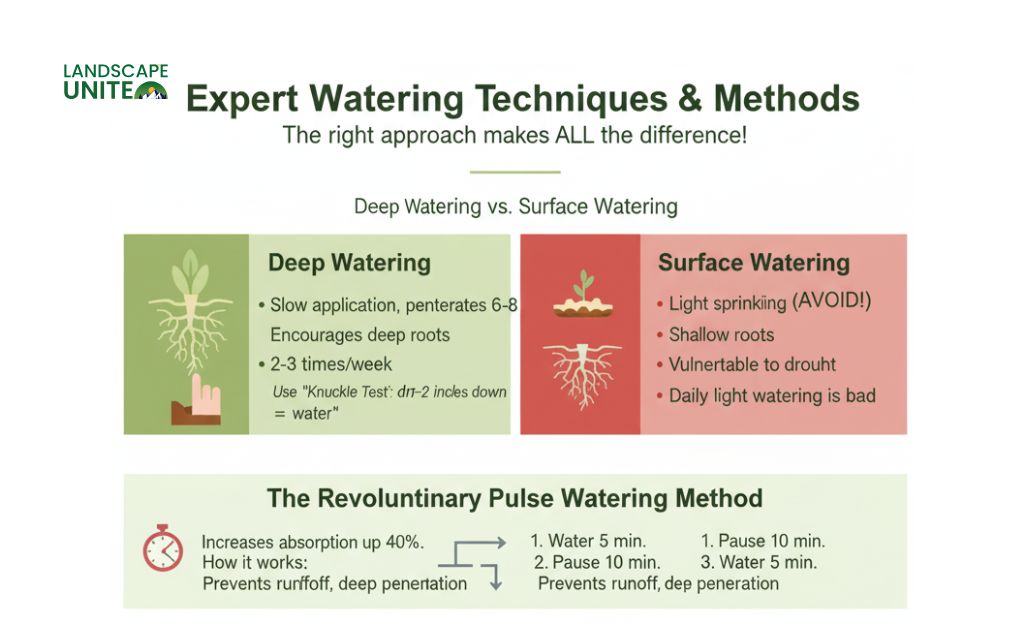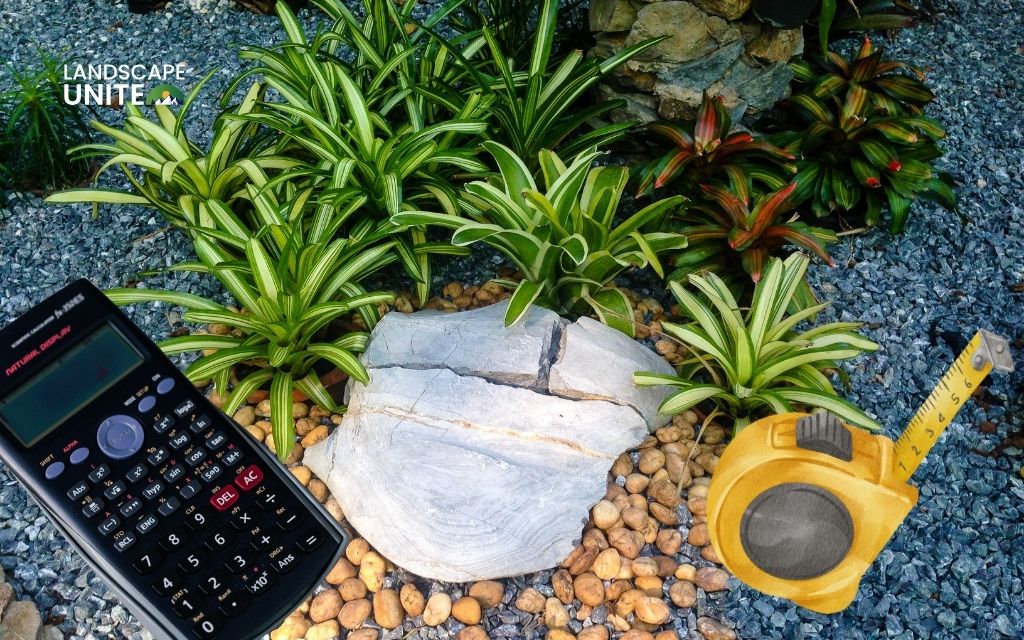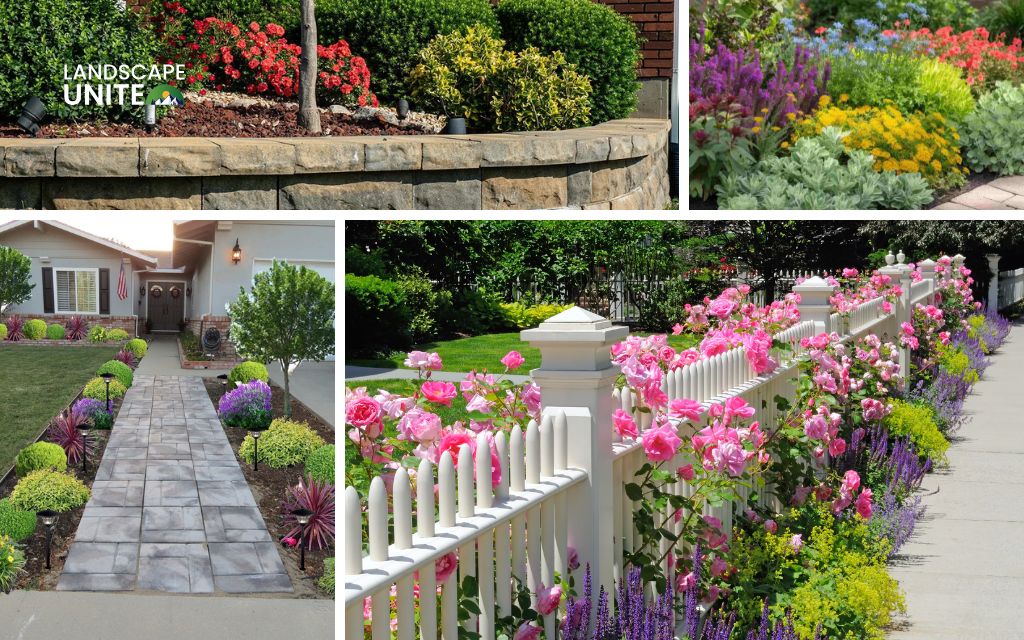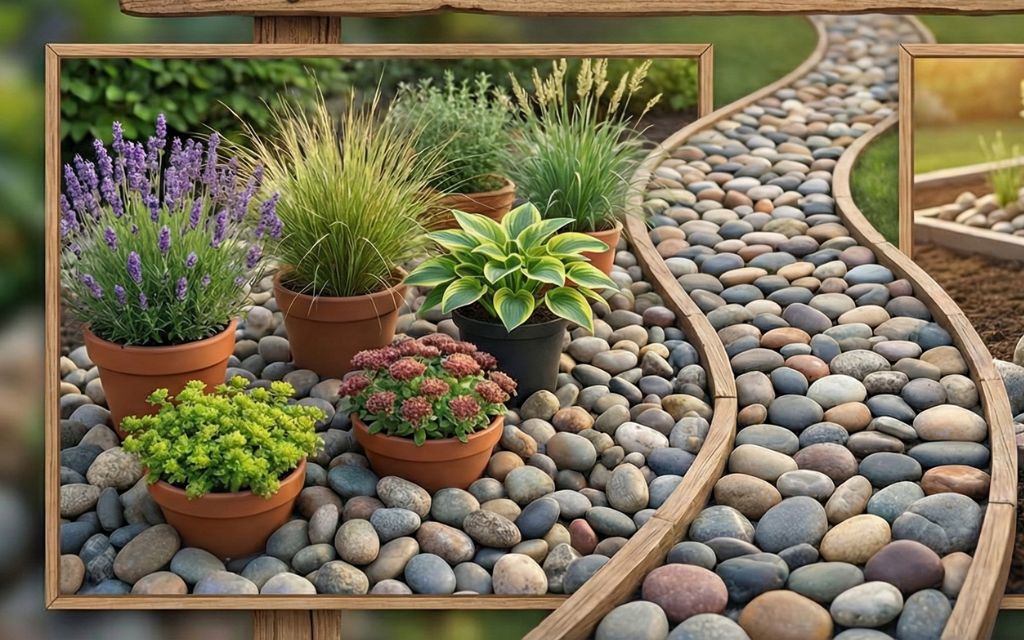Have you ever wondered why some gardens burst with vibrant blooms while others barely survive? The secret often lies in one fundamental practice: watering flowers properly. It’s not just about turning on the hose, it’s about understanding what your plants truly need.
Proper watering flowers is the cornerstone of successful gardening, yet it remains one of the most misunderstood aspects of plant care. Whether you’re nurturing container plants on your patio or managing expansive flower beds, mastering these techniques can transform your garden from surviving to thriving.
This comprehensive guide reveals professional secrets, scientific insights, and time-tested methods that ensure your flowers receive optimal hydration. You’ll discover the revolutionary “pulse watering” technique, learn why timing matters more than frequency, and understand how to read your plants’ moisture needs like an expert.
From avoiding common overwatering mistakes to implementing water-saving strategies, we’ll address every aspect of flower hydration. By applying these proven techniques, you’ll achieve more vibrant blooms and develop the confidence to adapt your approach to any flower variety or growing condition.
Understanding flower water requirements
Before you can master watering flowers, you need to understand what’s happening beneath the soil surface. Think of your flowers as tiny water management systems that need the right balance to function properly.
Key watering factors at a glance
| Factor | What It Means | Why It Matters |
| Transpiration Pull | Plants actively draw water from roots to leaves through evaporation | Creates continuous water flow for nutrient transport and plant health |
| Weekly Water Needs | Most flowers need 1 to 1.5 inches per week (including rainfall) | Provides baseline for adjusting your watering schedule |
| Root Zone Targeting | Water applied within the plant’s drip line (outer branch area) | Reduces water waste by 30% while improving plant health |
| Soil Depth | Water should penetrate 6 to 8 inches deep | Encourages deeper root growth and drought resistance |
The science behind plant hydration
Plants don’t just absorb water passively. They actively pull moisture from the soil through a fascinating process called “transpiration pull.” As water evaporates from leaf surfaces, it creates a suction effect that draws water up from the roots through the stems. This continuous water column is essential for nutrient transport and plant health.
Understanding this baseline helps you adjust your watering schedule appropriately. The roots are where the magic happens, so that’s where your water should go.
Root zone targeting: Why location matters
Where you water matters just as much as how much you water. Professional gardeners use the “root zone targeting” method, which focuses water application within the plant’s drip line. This technique reduces water waste by 30% while improving plant health.
When you water a flower, aim for the soil around the root zone rather than the leaves. Wet foliage can promote fungal diseases and doesn’t contribute to the plant’s hydration needs.
Transpiration and water uptake process
Think of transpiration as your plant’s breathing system. During daylight hours, plants open tiny pores called stomata to absorb carbon dioxide for photosynthesis. This process simultaneously releases water vapor, creating the pull that draws more water from the roots.
Understanding this process helps explain why timing your watering matters. When you provide water before peak transpiration times, your plants can stock up on moisture reserves before facing the day’s heat stress.
Optimal timing for watering flowers
When should you water flowers? This question puzzles many gardeners, but the answer can dramatically impact your garden’s success. Timing isn’t just important, it’s often more crucial than frequency.

Best watering times by season
| Time of Day | Best For | Key Benefits | Important Notes |
| Early Morning (6-8 AM) | All seasons, all flower types | Water soaks in before evaporation; foliage dries quickly; plants prepare for daily heat | Optimal choice for watering flowers |
| Late Afternoon (4-6 PM) | Summer heat, second watering for containers | Less evaporation than midday; still time for foliage to dry | Avoid watering after sunset |
| Midday (Avoid) | Emergency only | None | High evaporation; potential leaf scorch; water waste |
| Night (Avoid) | Not recommended | Lower evaporation | Promotes fungal diseases; foliage stays wet too long |
Early morning: The golden hour advantage
When is the best time to water your flowers? Early morning, specifically between 6 and 8 AM, is optimal for watering flowers. This timing offers multiple benefits that professional gardeners have relied on for generations.
During these cooler hours, water has time to soak deep into the soil before the sun’s heat increases evaporation rates. Your plants can absorb moisture and prepare for the day’s transpiration demands. Additionally, any water that accidentally lands on foliage has time to dry before nightfall, reducing fungal disease risks.
Ancient civilizations, including those who maintained the Hanging Gardens of Babylon, understood this principle and developed sophisticated irrigation systems timed to early morning hours.
Evening watering: Benefits and precautions
When should you water your flowers if morning isn’t possible? Evening watering serves as an acceptable alternative, particularly during hot summer months. The cooler temperatures mean less evaporation and more water reaching the root zone.
However, avoid watering too late. If you water flowers in the evening, aim for the period between 4 and 6 PM. This allows foliage to dry before nightfall, preventing fungal issues that thrive in damp, dark conditions. Never water after sunset unless absolutely necessary.
Seasonal timing adjustments
How often should you water your flowers changes with the seasons. Spring establishment requires different timing than summer heat management. During spring, when temperatures are moderate and rainfall more frequent, adjust your schedule accordingly. In summer, you might need to water more frequently, possibly even twice daily for container plants during extreme heat.
Fall preparation involves gradually reducing watering frequency as plants enter dormancy. Winter care for evergreen flowers might require occasional watering during dry spells when the ground isn’t frozen.
Expert watering techniques and methods
Now that you understand when to water, let’s explore how to water flowers effectively. The right technique can make the difference between mediocre results and spectacular blooms.

Deep watering vs. surface watering
Should you water flowers everyday with light sprinkling? Absolutely not. This common mistake encourages shallow root development, making plants vulnerable to drought stress.
Deep watering involves applying water slowly until it penetrates 6 to 8 inches into the soil. This encourages roots to grow deeper, creating stronger, more resilient plants. Most established flowers need deep watering 2 to 3 times per week rather than daily light watering.
How much water do flowers need? As a general rule, provide enough water to moisten the root zone thoroughly. For garden beds, this typically means 1 to 1.5 inches of water per week, including rainfall. Use the “knuckle test” by inserting your finger 1 to 2 inches into the soil. If it feels dry at that depth, it’s time to water.
The revolutionary pulse watering method
Here’s a breakthrough technique that’s changing how professionals approach watering flowers: pulse watering. Recent studies show this method can increase water absorption by up to 40% compared to single long watering sessions.
How pulse watering works:
- Water your flower beds for 5 minutes
- Pause for 10 minutes to allow water to soak in
- Water again for another 5 minutes
- Repeat if needed for deep penetration
This prevents runoff and ensures water penetrates deeply rather than pooling on the surface or running off compacted soil. This technique proves especially valuable for clay soils or sloped areas where water tends to run off before soaking in.
Container vs. ground flower watering
How often to water flowers in pots differs significantly from watering flower beds. Containers present unique challenges because they dry out much faster than ground plantings.
| Planting Type | Frequency | Amount | Special Considerations |
| Container Flowers | Daily in summer, sometimes twice in extreme heat | Water until draining from bottom holes | Check top inch of soil daily; consider bottom watering for thorough saturation |
| Ground Plantings | 2-3 times weekly | 1 inch per session (including rainfall) | Less frequent but deeper watering; use knuckle test at 2-inch depth |
| Hanging Baskets | Once or twice daily in summer | Until water drains freely | Dry out fastest; consider self-watering inserts |
| Raised Beds | 3-4 times weekly | Slightly more than ground beds | Drain faster than ground level; monitor more closely |
How often should I water flowers in containers? During summer, container flowers typically require daily watering, sometimes twice daily during extreme heat. Check soil moisture by feeling the top inch of soil. If it’s dry, it’s time to water.
When watering flowers in containers, water until you see it draining from the bottom holes. This ensures the entire root ball receives moisture. For hanging baskets, which dry out even faster, consider bottom watering occasionally by placing the container in a tray of water for 15 to 20 minutes.
Ground plantings, in contrast, benefit from less frequent but deeper watering. How often to water flower garden beds? Typically 2 to 3 times weekly, providing about 1 inch of water each session when including rainfall.
Essential tools and equipment
Having the right tools makes watering flowers more efficient and effective. You don’t need expensive equipment, but choosing appropriate tools for your garden size and layout makes a significant difference.

Watering tools comparison
| Tool | Best For | Key Benefits | Usage Tips |
| Watering Can | Small gardens, containers, precise watering | Targets root zone; prevents waste; portable | Choose long spout for reaching under foliage; look for removable rose head |
| Garden Hose with Nozzle | Medium to large gardens, versatility | Adjustable patterns; reaches distant areas | Use gentle shower setting; avoid harsh jets that compact soil |
| Drip Irrigation | Large beds, water conservation, automation | Delivers water directly to roots; minimal evaporation; can automate | Install with timer for consistent watering; check emitters regularly |
| Soaker Hose | Flower beds, efficient ground watering | Slow, deep watering; reduces evaporation by 50% | Bury under mulch for best results; run for longer periods at low pressure |
| Sprinkler System | Established beds, large areas | Covers wide areas; can automate | Not ideal for new plantings; use only in early morning |
| Soil Moisture Meter | All gardens, precision monitoring | Removes guesswork; measures at root depth | Insert to root zone depth; compare readings across garden |
Watering cans: Selection and proper use
For small gardens or container plants, a quality watering can remains your best friend. Look for one with a long spout that reaches under foliage to target the root zone. A removable rose (the sprinkler head) gives you flexibility for different watering needs.
The best way to water flower beds with a watering can involves moving methodically from plant to plant, delivering water directly to the soil surface. This precision prevents wasting water on pathways or non-planted areas.
Irrigation systems for flower gardens
For larger gardens, consider investing in proper irrigation systems. Drip irrigation and soaker hoses deliver water directly to root zones with minimal evaporation loss. These systems can be connected to timers, ensuring consistent watering even when you’re away.
Garden hoses with adjustable nozzles offer versatility for various watering tasks. Choose nozzles that provide gentle shower patterns rather than harsh jets that can damage delicate flowers or compact soil.
Sprinkler systems work for established flower beds but aren’t ideal for newly planted flowers. They wet foliage unnecessarily and waste water through evaporation, especially when used during midday hours.
Moisture monitoring tools
Professional gardeners use soil moisture meters to take the guesswork out of watering. These inexpensive tools measure moisture levels at root depth, telling you precisely when plants need water.
However, the simple “knuckle test” works just as well for most gardeners. Insert your finger 1 to 2 inches into the soil. If it feels dry at that depth, your flowers need water. This tactile method helps you develop an intuitive understanding of your garden’s needs.
Seasonal watering strategies
How often should you water flowers? The answer changes with the seasons. Adapting your approach to seasonal conditions ensures optimal plant health year-round.
Seasonal watering guide
| Season | Frequency | Special Focus | Key Adjustments |
| Spring | 1-2 times weekly for established plants; daily for new plantings (first 2 weeks) | Root establishment; utilize natural rainfall | Check soil before watering; rainfall often sufficient; reduce frequency as roots establish |
| Summer | 2-3 times weekly for beds; daily for containers | Heat stress management; prevent drought damage | Water early morning; containers may need twice daily; watch for wilting signs; increase frequency during heat waves |
| Fall | 1-2 times weekly, gradually decreasing | Prepare plants for dormancy; maintain root moisture | Reduce frequency as temperatures cool; deep water before first freeze; continue until ground freezes |
| Winter | Occasionally during dry spells (when ground not frozen) | Evergreen protection; prevent desiccation | Water only during warm periods; focus on evergreen perennials; minimal watering needed for dormant plants |
Spring establishment watering
Spring presents unique watering challenges, especially for newly planted flowers. How often to water newly planted flowers? Water them daily for the first two weeks, then gradually reduce frequency as roots establish.
During spring, rainfall often provides significant moisture. Check soil moisture before watering to avoid overwatering. The combination of moderate temperatures and regular rain means established plants may need watering only once or twice weekly.
Summer heat management
How often should flowers be watered during summer? This is when your watering schedule intensifies. Heat stress increases transpiration rates, meaning flowers need more frequent watering to maintain health.
Best time of day to water flowers in summer remains early morning, but container plants might need a second watering in late afternoon. Watch for signs of drought stress like wilting or leaf curling, and respond promptly.
How long to water flowers depends on your soil type and weather conditions. Clay soils need longer, slower watering sessions. Sandy soils require shorter but more frequent watering. During extreme heat waves, even established flower gardens might need daily attention.
Fall preparation and winter care
As temperatures cool, gradually reduce watering frequency. Do you water flowers everyday in fall? No, established plants typically need water only once or twice weekly as they prepare for dormancy.
However, don’t neglect fall watering entirely. Plants need adequate moisture to withstand winter stress. Water deeply before the ground freezes to help roots survive cold temperatures.
Do flowers need water everyday during winter? Generally no, but evergreen perennials and flowers in protected microclimates might need occasional watering during dry winter periods when the ground isn’t frozen.
Common watering mistakes and solutions
Even experienced gardeners make watering errors. Recognizing these mistakes helps you avoid them and troubleshoot problems when they arise.
Quick problem solver
| Problem | Signs to Watch For | Immediate Solution | Long-Term Prevention |
| Overwatering | Yellowing leaves (especially lower ones); musty soil odor; fungal growth; wilting despite wet soil | Stop watering immediately; improve drainage; remove damaged foliage | Check soil before watering; water less frequently but more deeply; improve soil structure with organic matter |
| Underwatering | Wilting during heat; dry crispy leaf edges; slow growth; premature flower drop | Deep water gradually over several days; don’t flood suddenly | Establish consistent schedule; use mulch; check soil moisture regularly with knuckle test |
| Midday Watering | Rapid evaporation; water waste; occasional leaf scorch | Switch to early morning watering | Set reminders for 6-8 AM watering; install automatic timers |
| Shallow Watering | Weak surface roots; plants wilt quickly; poor drought tolerance | Begin deep watering sessions; let water penetrate 6-8 inches | Water 2-3 times weekly instead of daily; use pulse watering method |
| Wetting Foliage | Fungal spots; powdery mildew; leaf diseases | Remove affected leaves; water soil only | Use soaker hoses or drip irrigation; direct watering can spout under leaves |
Overwatering: Signs, causes, and prevention
Overwatering kills more flowers than underwatering. How can you tell if you’re giving too much water? Watch for these signs of overwatering flowers in garden settings: yellowing leaves (especially lower leaves), musty soil odor, fungal growth around the base, and wilting despite moist soil.
The soil should feel slightly moist, not waterlogged. If water pools on the surface or if soil feels soggy hours after watering, you’re applying too much water too quickly.
Prevent overwatering by checking soil moisture before watering and improving soil drainage with organic matter. Remember, watered flowers don’t always mean properly hydrated flowers.
Underwatering: Recognition and recovery
Underwatering shows different symptoms: wilting during the hottest part of the day, dry and crispy leaf edges, slow growth, and premature flower drop. How much water does flowers need to recover? Provide a thorough deep watering, then maintain consistent moisture levels.
For severely stressed plants, avoid the temptation to flood them with water. Gradually increase moisture over several days to prevent shock.
The wrong time trap: Midday watering issues
Should you water flowers everyday at noon? Never if you can avoid it. Midday watering wastes water through rapid evaporation and can cause leaf scorch when water droplets act as tiny magnifying glasses in bright sunlight.
If you must water during midday heat, focus water strictly on the soil surface and avoid wetting foliage. However, always aim for morning watering whenever possible.
Water conservation and efficiency
Smart watering practices benefit both your garden and the environment. These water-saving strategies maintain beautiful blooms while reducing consumption.
Mulching for moisture retention
Applying 2 to 3 inches of organic mulch around your flowers reduces watering needs by up to 50%. Mulch slows evaporation, moderates soil temperature, and improves moisture retention. This simple practice means you can reduce how often to water outdoor flowers while maintaining plant health.
Choose organic mulches like shredded bark, compost, or leaf mold. As they decompose, they improve soil structure and enhance the beneficial mycorrhizal fungi partnerships that increase drought resistance by up to 50%.
Rainwater collection systems
Collecting rainwater provides free, chemical-free water for your flowers. Rain barrels connected to downspouts capture hundreds of gallons annually. This harvested water works perfectly for watering the flowers, as it’s naturally soft and at ambient temperature.
Use collected rainwater for container plants and flower beds during dry periods. This reduces your water bills and provides plants with optimal hydration.
Drought-resistant flower selection
Choosing flowers adapted to your climate dramatically reduces watering demands. Native perennials and drought-tolerant annuals need less frequent watering once established. This doesn’t mean sacrificing beauty; many stunning flowers thrive with minimal water.
Group plants with similar water needs together. This “hydrozoning” approach ensures you’re not overwatering drought-tolerant plants or underwatering moisture-loving varieties.
Troubleshooting watering problems
Sometimes despite your best efforts, plants show stress symptoms. Here’s how to diagnose and solve common watering-related issues.
Diagnosing plant stress symptoms
How do you know if watering is the problem? Start with the soil. Is it too wet, too dry, or just right? Check root health by gently excavating near the plant base. Healthy roots are white or light-colored and firm. Brown, mushy roots indicate overwatering, while dry, brittle roots suggest underwatering.
Leaf symptoms provide clues too. Yellow leaves with brown spots often indicate overwatering, while crispy brown edges suggest underwatering. Wilting can mean either extreme, so always check soil moisture before adjusting your schedule.
Soil drainage issues
Poor drainage causes persistent overwatering problems regardless of how carefully you water. Does water pool on the surface? Does soil remain soggy for days? These signs indicate drainage problems that need correction.
Improve drainage by working organic matter into the soil, creating raised beds, or installing drainage systems. For severe cases, you might need to redirect water flow or choose different planting locations.
Mycorrhizal enhancement for better water uptake
Here’s a cutting-edge discovery: specific watering patterns can enhance mycorrhizal fungi partnerships with flower roots. These beneficial fungi extend root systems’ effective reach, improving water and nutrient uptake.
Encourage mycorrhizal development by avoiding overwatering and maintaining consistent moisture levels. These fungi thrive in slightly dry conditions between waterings, so the deep watering approach naturally supports their growth.
If you’re struggling with persistent watering issues or need professional guidance, explore our detailed guides on soil improvement and garden maintenance for comprehensive solutions tailored to your specific situation.
FAQs about watering flowers
How often should I water my flowers?
Most established flowers need deep watering 2 to 3 times per week rather than daily light watering. Use the “knuckle test” by checking soil moisture 1 to 2 inches deep to determine the most accurate timing for your specific conditions.
What’s the best time of day to water flowers?
Early morning between 6 and 8 AM is optimal, allowing plants to absorb water before heat increases evaporation. Evening watering between 4 and 6 PM is acceptable but avoid late night watering to prevent fungal issues.
How can I tell if I’m overwatering my flowers?
Key signs include yellowing leaves, musty soil odor, fungal growth, and wilting despite moist soil. The soil should feel slightly moist, not waterlogged. If you notice these symptoms, reduce watering frequency and improve soil drainage.
Should I water flower leaves or just the soil?
Focus water application on the soil around the root zone. Wet foliage promotes fungal diseases and doesn’t benefit the plant’s hydration needs. Target the drip line area for most efficient water delivery.
How much water do container flowers need compared to garden beds?
Container flowers typically require daily watering in summer as pots dry out faster. Garden beds need deeper, less frequent watering, about 1 to 1.5 inches weekly including rainfall. Check container soil daily during hot weather and adjust accordingly.
Conclusion
Mastering the art of watering flowers transforms your garden into a thriving showcase of vibrant blooms and healthy plants. By implementing these expert techniques, from pulse watering methods to optimal timing strategies, you’ll develop the intuitive skills that separate successful gardeners from those who struggle.
Remember these key takeaways:
- Water deeply 2 to 3 times weekly rather than daily
- Choose early morning hours for optimal absorption
- Use the knuckle test to check soil moisture
- Apply water to the root zone, not foliage
- Adjust frequency based on season and plant type
Take action today by evaluating your current watering practices and implementing one new technique from this guide. Your flowers will reward you with stronger growth and more spectacular blooms.
Landscape Unite serves as your comprehensive resource for gardening excellence and landscape beautification, offering expert-curated content that helps gardeners at every skill level achieve their outdoor goals.
Ready to elevate your gardening expertise? Contact Landscape Unite for more professional tips, seasonal guides, and discover our extensive collection of gardening resources that will transform your landscape into the outdoor paradise you’ve always envisioned.


